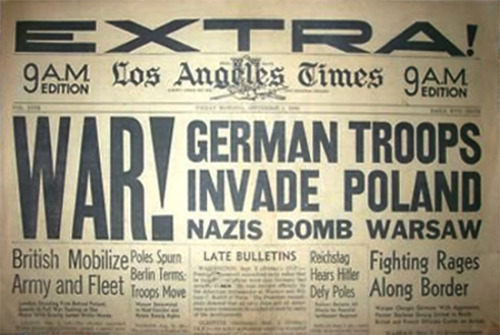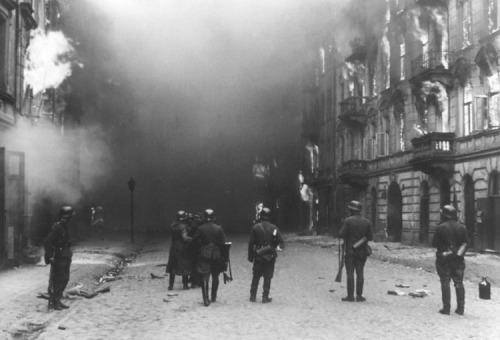The September Campaign

On September 1, 1939, the Axis Powers launched the September Campaign – their invasion of Poland. Over a million and a half troops, from 3 different sides – Germany from the West, East Prussia from the North, and Slovakia from the South. The size of the attack was never seen before.
Germany, alone, came with 2,600 tanks and 2,000 aircraft. While Poland only had some 180 tanks and 420 aircraft.
The thing is, Poland hand long-known the attack was coming. In fact, with the threat hanging over their heads, Poland signed an agreement with Britain and France – the Agreement of Mutual Assistance, in which both countries agreed to come to Poland’s aid when Germany invaded.
Poland did prepare itself for Hitler’s inevitable invasion by digging trenches, setting up blockades, and arming themselves. However, “Poland’s French and British allies bullied the Poles into delaying mobilization out of fear of ‘provoking’ Hitler. As a result, only part of the Polish army was ready when the attack came” (Source).
But first, some important background: It may seem like a simple “Hitler invaded Poland,” but as is always the case with Hitler, there is more to the story.
See, in 1934, only a year after Hitler had come to power, he played a similar game with Poland we saw him play with the Soviet Union by signing the German-Soviet Non-Aggression Pact. He proposed a “treaty” with Poland, The German-Polish Non-Aggression Pact, in which “both countries pledged to resolve their problems by bilateral negotiations and to forgo armed conflict for a period of 10 years” (Source). Or make that 4 ½ years.
But again, like with the Soviet Union, Hitler was already, of course, we’re all sure, planning to break the pact.
For example, Hitler had been trying to break the ties between Poland and France. He also tried maneuvering Poland into the Anti-Communist Pact, “forming a cooperative front against the Soviet Union” (Source). Despite his pact with the Soviet Union.
Hitler made Poland great promises if they agreed to cooperate – such as territory in Ukraine and Belarus. However, this agreement would also, technically, make Poland “largely dependent” on Germany. Sounds a bit like a trap.
Additionally, Poland held a piece of land known as the “Polish Corridor” as well as Danzig – land that had became part of Poland after the Treaty of Versailles. Land that Germany desperately wanted back. Land that Hitler saw as the perfect reason for war.
The story, unsurprisingly, continues.
After “several German-staged incidents,” (to be discussed in a later post. Promise.) Hitler attacked, claiming he was doing it in self-defense (Source). There you have it. Hitler used propaganda to “excuse” his absurd desire for war.
[Below: German armies marching into Poland.]

At 4:40, the Luftwaffe attacked Wieluń, “destroying 75% of the city and killing close to 1,200 people” (Source). Five minutes later, the German pre-dreadnaught battleship Schleswig-Holstein opened fire on Westerplatte. At 5:00, the German army attacked Mokra. All three assaults (German, Prussian, and Slovakian) converged in Warsaw.
“Warsaw everywhere was burning. Huge billowing columns of smoke filled the sky with thick massive clouds as red as blood. Railway tracks were so heavily bombed that they became like twisted pretzels. Huge craters where
bombs had been dropped lined every street in Warsaw, and other cities. Enormous hills of rubble marked areas where buildings used to stand, and protruding from the rubble were scattered the bodies of people who had been crushed beneath the collapsed buildings. Military posts, as well as residential areas were bombed and strafed. Defenseless civilians were gunned down as they ran from burning buildings. Peasants were massacred as they worked in the fields in the countryside. Men, women, and children were slaughtered. Churches, schools, hospitals, monuments, museums – all were targets for destruction. The Polish people, their culture, and the very existence of the Polish nation were targeted by Hitler for annihilation. Warsaw, the Paris of the east was transformed into a wasteland – an open grave” (Source).
It wasn’t until September 3rd that Britain and France declared war on the Axis – thus beginning WWII. However, they failed to provide the support Poland really needed. Prime Minister Chamberlain merely dispatched the RAF to drop leaflets over German armies! Meanwhile, the British Expeditionary Force joined French forces along the Maginot Line. This “farce” became known as the Phoney War because Britain and France mainly kept themselves busy over the next several months with pointless raids into No-Man’s Land and bombings over the Siegfried Line.
The Polish military saw some minor victories, but ultimately, they were pushed back from their own borders towards Warsaw and Lwów.
Thanks to their destroying Polish communications, coupled with the approximately 98 airman who retreated to the then-neutral Romania, the Luftwaffe easily opposed the Polish Air Force.
- September 9: Warsaw is attacked
- September 9-19: The Battle of Bzura takes place, the largest battle during the campaign.
- September 10: Commander-in-Chief Marshal Edward Rydz-Śmigły orders a general retreat to the southeast. The Germans are “penetrating deeply into Eastern Poland”
- September 13: Warsaw is under siege. Also, German armies reach Lwów.
- September 17: The Soviet Union joins forces with Germany – attacking from the east
- September 24: Warsaw is bombed by 1,150 German aircraft
The Soviet joined the battle at over 800,000 strong, breaking, of course, the Soviet-Polish Non-Aggression Pact. It was at the time that the Soviets attacked that Poland realized their defeat.
“The campaign against Poland was conducted with a cruelty previously unknown in modern European warfare. Polish civilians and prisoners of war were systematically shot by German and Soviet forces. Although the Nazi SS and Einsatzgruppen and the Soviet NKVD committed the worst crimes, regular army and air forces of both totalitarian states were full and willing participants in the slaughter. The German use of Einsatzgruppen or special action units in Poland was a test run. The death and destruction carried out deliberately by the Wehrmacht and the police during the period of military control of the country between September 1 and October 25, 1939 was merciless and systematic” (Source).
From September 17-20, Poland fought the 2nd largest battle, the Battle of Tomaszów Lubelski at Kraków and Lublin. On September 22, Lwów fell to the Soviets, having suffered from German attack just days prior. Warsaw held out until the 28th, falling on the 29th to the Germans.
On October 6th, General Franciszek Kleebergy surrendered near Lublin.
531 towns and villages were burned. “714 executions took place with over 16,000 civilian victims, most of them Christian Poles” (Source).
[Below: Warsaw Burning]

Up Next:
Battle of the Atlantic

